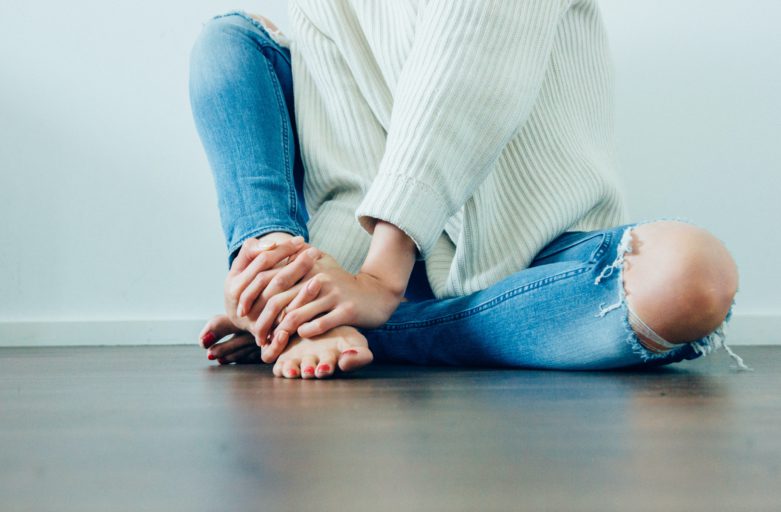Having been a Pilates instructor for many years now, I often get people coming to classes with sciatica – it’s a very common condition, and can be extremely painful.
What is sciatica?
Nerve pain from an injury or irritation to the sciatic nerve is commonly called Sciatica. The sciatic nerve is the longest and thickest nerve (around a thumb width) in your body, and originates in your butt/gluteal area. On each side of your body, one sciatic nerve runs through your hips, buttocks and down a leg, ending just below the knee. The sciatic nerve then branches into other nerves, which continue down your leg and into your foot and toes – this is why it can be felt all the way down into the foot.
A true injury to the sciatic nerve “sciatica” is actually very rare, but the term “sciatica” is commonly used to describe any pain that originates in the lower back and radiates down the leg. What this pain shares in common is an injury to a nerve — an irritation, inflammation, pinching or compression of a nerve in your lower back.
If you have “sciatica,” you experience mild to severe pain anywhere along the path of the sciatic nerve – that is, anywhere from the lower back, through the hips, buttocks and/or down your legs. It can also cause muscle weakness in your leg and foot, numbness in your leg, and an unpleasant tingling pins-and-needles sensation in your leg, foot and toes.
Risk Factors for Sciatica
You are at greater risk of sciatica if you:
- Have an injury/previous injury: An injury to your lower back or spine puts you at greater risk for sciatica.
- Live life: With normal aging comes a natural wearing down of bone tissue and disks in your spine. Normal aging can put your nerves at risk of being injured or pinched by the changes and shifts in bone, disks and ligaments.
- Are overweight: Your spine is like a vertical crane. Your muscles are the counterweights. The weight you carry in the front of your body is what your spine (crane) has to lift. The more weight you have, the more your back muscles (counterweights) have to work. This can lead to back pains and other back issues.
- Lack a strong core: Your “core” are the muscles of your back and abdomen. The stronger your core, the more support you’ll have for your lower back. Unlike your chest area, where your rib cage provides support, the only support for your lower back is your muscles.
- Have an active, physical job: Jobs that require heavy lifting may increase your risk of low back problems and use of your back, or jobs with prolonged sitting may increase your risk of lower back pain
- Lack proper posture in the weight room: Even if you are physically fit and active, you can still be prone to sciatica if you don’t follow proper body form during weight lifting or other strength training exercises.
- Have diabetes: Diabetes increases your chance of nerve damage, which increases your chance of sciatica.
- Have osteoarthritis: Osteoarthritis can cause damage to your spine and put nerves at risk of injury.
- Lead an inactive lifestyle: Sitting for long period of time and not exercising and keeping your muscles moving, flexible and toned can increase your risk of sciatica.
- Smoke: The nicotine in tobacco can damage spinal tissue, weaken bones, and speed the wearing down of vertebral disks.
How is sciatica treated?
The goal of treatment is to decrease your pain and increase your mobility. Depending on the cause, many cases of sciatica go away over time with some simple self-care treatments.
Self-care treatments include:
- Appling ice and/or hot packs: First, use ice packs to reduce pain and swelling. Apply ice packs or bag of frozen vegetables wrapped in a towel to the affected area. Apply for 20 minutes, several times a day. Switch to a hot pack or a heating pad after the first several days. Apply for 20 minutes at a time. If you’re still in pain, switch between hot and cold packs – whichever best relieves your discomfort.
- Taking over-the-counter medicines: Take medicines to reduce pain, inflammation and swelling.
- Performing gentle stretches: Learn proper stretches from an instructor with experience with low back pain. Work up to other general strengthening, core muscle strengthening and aerobic exercises.
If you’d like to learn some of the recommended stretching and muscle releasing exercises then there is a copy of the recording from a workshop that I ran in my studio all about the causes of sciatica, exercises to avoid, exercises that are safe, and how to avoid another flare up. Get your workshop recording here.

